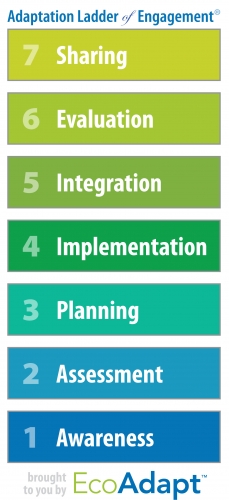EcoAdapt's Adaptation Ladder of EngagementTM
EcoAdapt's Adaptation Ladder of Engagement helps you assess your "State of Adaptation" to determine what you could be doing improve your efforts to address climate change. EcoAdapt works with federal, tribal, state, and local agencies, NGOs, and other organizations to ensure that their adaptation efforts are effective and efficient. If you are interested in us helping you with any of these steps, contact our Awareness of Action Program Coordinator: Alex Score, Alex@EcoAdapt.org.

The Adaptation Ladder of Engagement (ALoE) is composed of seven rungs:
- Awareness – Climbing a ladder requires that you know the ladder exists and you take a first step up and on. In the case of adaptation, it is an awareness that climate change affects your ability to meet your goals, either by altering the effectiveness of the tools you use to achieve your goal or by undermining your goal itself. Either way you are making investments (time, money, political capital) to achieve your goal and those investments are vulnerable if you are not aware of (and taking into consideration) climate change.
- Assessment – The second rung is getting a better feel for the scope of the problem. This could take many forms, including a general review or a more formal vulnerability or risk assessment. Regardless of the approach, the key is to systematically assess how climate change might affect your work or other investments of time and money. How might climate change affect your ability to achieve your goals? Will climate change make your strategy less effective?
- Planning – Knowing your vulnerability should not result in paralysis. Rather it should inspire you to develop a strategy! Rung three moves from assessing the problem to identifying solutions. Based on the risks or opportunities identified in Rung 2, what you can do to reduce your vulnerability and increase your likelihood of better long-term outcomes? This might be a revision of some existing plan or process, or it might be a climate-focused Adaptation Action Plan that aims specifically to call out new activities or modifications.
- Implementation – It is not enough to have a plan. The next rung is to put your plan into action. This may mean implementing new laws, regulations, or processes, or it may be adjusting existing activities by changing what you do and how or when you do it. Just like the emergency maps on the wall in public buildings, your adaptation plans are only effective if you jump to your feet and follow the path to get the fire extinguisher, pull the alarm, or get out of the burning building.
- Integration – Adapting to climate change is not a one-time action. It is a process of integrating climate-savvy thinking into the way you approach your work, allowing you to assess, anticipate, or respond to changes in climate, ecology, or management effectiveness as they happen. The fifth rung of the adaptation ladder may be formal monitoring or adaptive management programs, or it may simply be consciously surfing the uncertainty wave.
- Evaluation – Fail early, fail often, learn quickly. It’s a great mantra and perhaps even more so for climate adaptation. Good adaptation is going to require monitoring and evaluation in order to determine what is working and what is not working. We need lessons learned NOW in order to improve adaptation practice and achieve the best possible outcomes for the future. Project monitoring and evaluation should be integrated throughout your adaptation efforts to make sure that investments of time and effort are not wasted.
- Sharing – It is great to build internal capacity and resilience, but for most of us our chances of long-term success are increased if we share with and learn from others. The larger we make the adaptation community, the easier it becomes to make it part of our own work.




